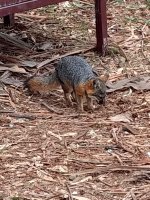Okay, so final wrap up: what did I miss and what would I do differently next time
I really had no major goals for the San Diego part of the trip: that was really focused on visiting with some friends and eating a lot of food, which I accomplished on both fronts. Yes, it would have been nice to see the Little Stint, and I think I could have had I brought my spotting scope. However I didn't, and the bird is even then not terribly reliable.
As far as the tour goes, overall it was a success, with most of the major targets seen, even if a few like the whydah and condor made us sweat. Not counting regular socal birds that I wasn't really targeting or a few local rarities, there were only a few species I missed:
Northern Red Bishop: This is another bird that, even though the population has been around for awhile, isn't considered established. Unlike some of the other birds however, this one is a lot harder to come by. Apparently the population goes through periods of extreme fluctuation in their numbers, and this was a "low" population year. We ran into a pair of birders on Santa Cruz which deliberately targeted this species and spent some time looking for it, but missed it. So I don't think more time spent in the field would have given us better results. Also sort of makes me wonder, between the population cycles and the limited distribution, if the population in the ABA area might be on its way out anyway, and not fated to ever be "countable" Although who knows...urban birds are neglected.
Nanday Parakeet: This is another established species that is doing quite well for itself; It's considered ABA countable despite not being on the California checklist yet. However it's center of distribution is focused more on the western portion of Los Angeles county, and we just didn't spend any time there (nor did the trip's itinerary suggest otherwise). At any rate, this bird has larger populations in Florida, so I have other opportunities to see this species without returning to Los Angeles.
Other L.A. area exotics: There are very small and not reliably seen populations of Orange-cheeked Waxbill and Bronze Munia. The former, much like the Bishop, seems to fluctuate a lot. It's not clear to me these species are really on the road to establishment yet, and seeing them would have been random luck. Ring-necked Parakeets are another bird that is sometimes seen, however the main California population is centered in Bakersfield, with only a few birds of dubious provenance in L.A. Again, we made no real effort for the species and weren't in the proper territory.
Overall I enjoyed my Wildside trip, however it seems like many of the shorter target tours might be getting phased out by being lumped into existing tour (This tour is apparently being merged with the San Diego based tour). Which is a shame because I don't think a comparable tour is out there, and for financial and interest reasons I would have never signed up for a longer California tour targeting birds I have already seen and could reasonably expect to find myself. I do wish Wildside published trip reports, which seems a bizarre thing to not include given that many folks probably use that information to figure out if a trip is worth going on. Not sure I will be going on another tour with the company, but that is more about their other destinations being of less interest to me than the quality of the trip I did go on, as there non lower-48 options are more limited.
Feel free to ask any other questions if you have them!








